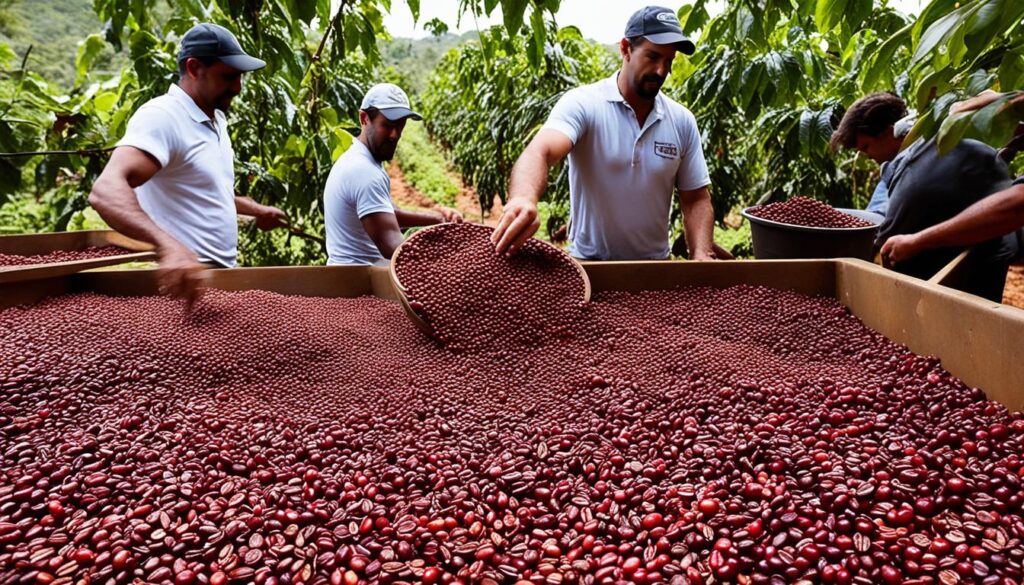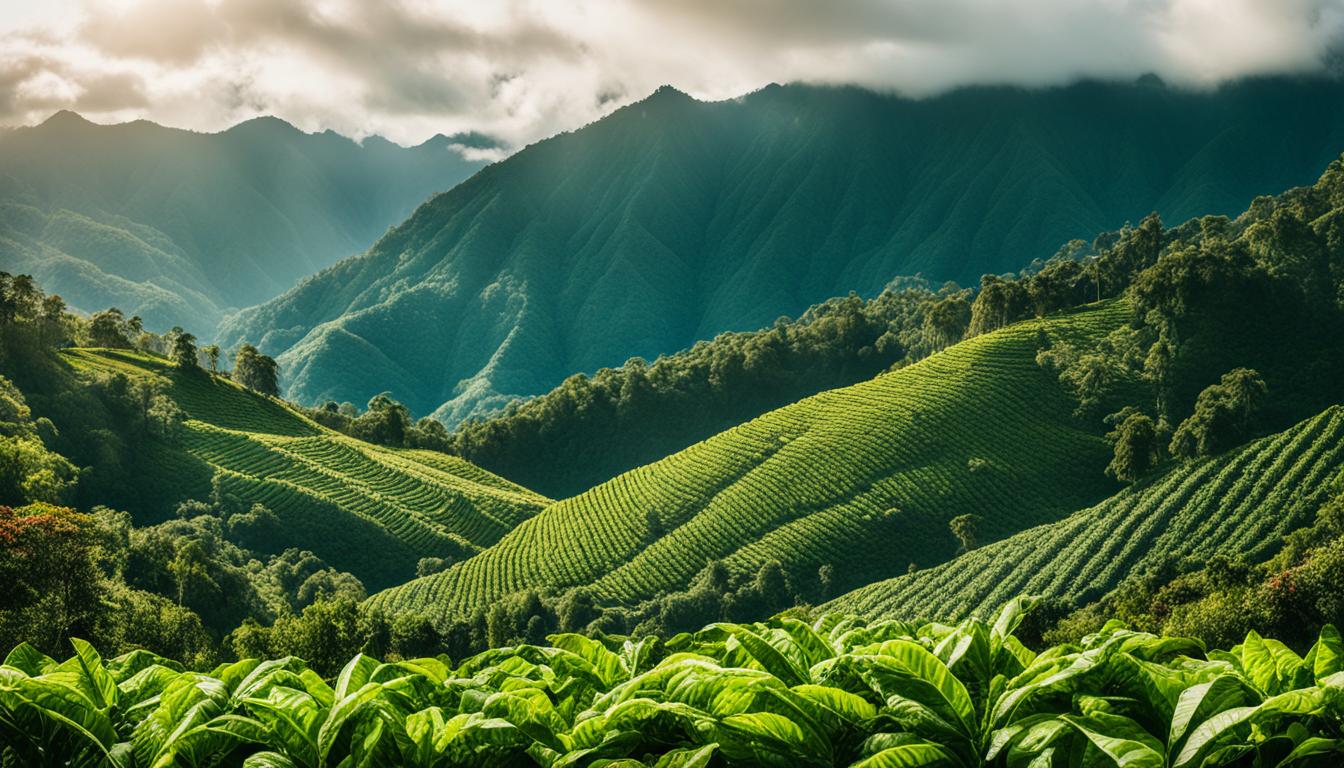Welcome to our in-depth exploration of coffee processing methods! Today, we are going to dive into the fascinating world of coffee production and uncover the secrets behind the different techniques used to process coffee beans. Understanding these methods will not only enhance your appreciation for the unique flavors and qualities of your favorite brew, but also allow you to make more informed choices when it comes to selecting and enjoying coffee. So, grab a cup of your preferred coffee and let’s embark on this flavorful journey together!
Key Takeaways:
- Coffee processing methods greatly influence the flavor and quality of the coffee beans.
- There are various coffee processing techniques, including natural (dry process), washed (wet process), pulped natural, and honey.
- Each processing method offers unique characteristics and flavor profiles.
- Understanding coffee processing methods helps coffee enthusiasts appreciate the craftsmanship behind their favorite brew.
- Stay tuned as we explore each coffee processing method in detail and uncover their secrets!
Natural – Dry Process
In the world of coffee processing, the natural or dry process is a time-honored method that brings out unique and intense flavors in coffee beans. This traditional technique is particularly popular in regions with limited water resources. Let’s dive into the fascinating world of natural coffee processing and discover its flavor profile, low investment costs, and the incredible array of unique flavors it produces.
During the natural coffee processing method, after the coffee cherries are harvested, they are carefully spread out to dry naturally under the sun. This allows the cherries to ferment and dry over a period of several weeks. The result is a coffee with an exquisite flavor profile that showcases distinct fruity and wine-like notes, coupled with a full-bodied richness.
One of the remarkable advantages of the natural process is its low investment costs. Since it requires minimal equipment and infrastructure, it is an attractive option for coffee farmers, especially in regions where access to water resources is limited. The simplicity of the process translates into potentially higher yields and cost savings, making it an economically viable method for coffee production.
Now, let’s explore the intriguing flavors that natural processed coffees offer. Picture yourself savoring a cup with notes of ripe berries, tropical fruits, and even a hint of chocolate. These unique flavors arise from the fermentation and drying process, which accentuates the inherent qualities of the coffee cherries. The natural process lends complexity and depth to the final cup, creating a truly memorable coffee experience.
Benefits of Natural Coffee Processing
The natural coffee processing method offers several notable benefits:
- Exciting and unique flavor profile: Natural processing brings out flavors that are distinct and different from other processing methods. The intense fruity and wine-like notes create a truly remarkable sensory experience.
- Low investment costs: Coffee producers can opt for the natural process without incurring substantial expenses, making it an accessible choice for farmers with limited resources.
- Potentially high yields: With proper drying conditions, the natural process can result in higher yields, providing an opportunity for increased productivity and profitability.
Tips for Brewing Natural Processed Coffees
If you’re fortunate enough to get your hands on a bag of natural processed coffee beans, here are a few tips to make the most of their unique flavors:
- Experiment with brewing methods: Natural processed coffees can shine in various brewing techniques, such as pour-over, French press, or espresso. Try different methods to find your perfect brew.
- Adjust your grind size: Natural processed coffees tend to be fuller-bodied. To accentuate their unique flavors, consider using a slightly coarser grind size to enhance the clarity of the cup.
- Explore different roast levels: From light to dark, different roast levels can reveal distinct aspects of the natural process. Don’t be afraid to experiment and discover your preferred roast profile.
With the natural coffee processing method, a world of unique flavors unfolds, offering a sensory journey like no other. Whether you’re a coffee enthusiast or a curious beginner, exploring the diverse range of natural processed coffees is sure to broaden your coffee horizons.
Washed – Wet Process
In specialty coffee production, the washed coffee processing method, also known as the wet process, is the most commonly used. This method ensures that the flavor and quality of the beans are carefully controlled throughout the process. Let’s take a closer look at how the wet process works:
- Harvesting and Depulping: After the coffee cherries are hand-picked at optimal ripeness, they are quickly transported to the processing facility. Here, the cherries go through a depulping machine that removes the outer layers, separating the coffee beans from the pulp.
- Fermentation: The depulped beans are then soaked in water for a specific period, allowing any remaining mucilage to be broken down and washed away. This fermentation stage is crucial in developing the flavors and characteristics of the coffee.
- Washing and Drying: Once the fermentation is complete, the beans are thoroughly washed to remove any residue. They are then spread out to dry, either on patios or raised beds, under the sun or using mechanical dryers. This step requires precise monitoring to ensure consistent drying and prevent the growth of mold or fungus.
The wet process offers several advantages, including greater control over the final flavor profile and improved consistency. By removing the cherry pulp before drying, the wet process results in coffees with a bright acidity and a clean finish. The balanced flavor profile makes washed coffees highly desirable among coffee enthusiasts.
Let’s take a closer look at the characteristics of washed coffees:
| Characteristics | Description |
|---|---|
| Acidity | Washed coffees are known for their vibrant and bright acidity. This acidity adds a refreshing and tangy quality to the flavor profile. |
| Clean Finish | The wet process ensures that any undesirable flavors or impurities are removed, resulting in a clean and crisp finish in the cup. |
| Quality Control | Due to the controlled nature of the wet process, farmers and roasters have better control over the outcome. This allows them to maintain consistent quality and flavor from batch to batch. |
| Consistency | Washed coffees are prized for their consistency. Coffee lovers can expect a balanced taste experience with each brew, ensuring a reliable and enjoyable cup every time. |
With its emphasis on quality control and consistent flavor, the washed coffee processing method has become a staple in the specialty coffee industry.

Stay tuned for the next section, where we will explore the honey-pulped natural process, a unique combination of the natural and washed methods that produces coffees with fruity flavors and complexity.
Honey-Pulped Natural Process
The honey-pulped natural processing method, also known as honey processing, combines elements of both the natural and washed methods. This innovative approach adds layers of complexity to the coffee beans, resulting in unique and delightful flavors.
During honey processing, after the cherries are depulped, a portion of the sticky-sweet fruit pulp is intentionally left on the beans as they dry. The amount of pulp left on the beans can vary, creating different types of honey processing such as white honey, yellow honey, and red honey.
Honey processed coffees are known for their distinct fruity flavors and intricate complexity. The remaining pulp on the beans during drying adds a touch of natural sweetness, making honey processed coffees a favorite among specialty coffee enthusiasts. The combination of fruity flavors, complexity, and sweetness results in a truly remarkable sensory experience.
Importance of Coffee Processing
When it comes to coffee, the journey from farm to cup is truly fascinating. One crucial step in this journey is coffee processing, which plays a pivotal role in developing the flavors and overall quality of the beans. The different coffee processing methods, such as the natural, washed, and honey-pulped natural processes, each contribute their unique characteristics to the final product.
Coffee enthusiasts have grown to appreciate the diverse flavors and sensory experiences derived from different coffee processing methods. For example, the natural process, also known as the dry process, brings forth intense and fruity flavors that captivate the palate. On the other hand, the washed process offers a clean and bright cup with a balanced flavor profile and distinct acidity. Meanwhile, the honey-pulped natural process provides complexity and sweetness, adding richness to the brew.
Understanding the significance of coffee processing allows us to appreciate the artistry and craftsmanship involved in creating our favorite coffee. It showcases the expertise of coffee farmers and the meticulous care taken to cultivate beans with outstanding flavor profiles. By exploring the impact of coffee processing on quality and unique characteristics, we can deepen our enjoyment and appreciation for this beloved beverage.
FAQ
What are coffee processing methods?
Coffee processing methods refer to the techniques used to transform coffee cherries into coffee beans. These methods include natural (dry process), washed (wet process), pulped natural, and honey processing. Each method impacts the flavor and attributes of the coffee beans.
What is the natural coffee processing method?
The natural coffee processing method, also known as the dry process, involves drying the coffee cherries in the sun. This traditional method allows the cherries to ferment and dry naturally, resulting in intense and unique flavors.
What is the washed coffee processing method?
The washed coffee processing method, also known as the wet process, is the most common method used in specialty coffee production. It involves removing the outer layers of the coffee cherries and fermenting the beans in water to remove any remaining mucilage. This method offers greater quality control and consistency in flavor.
What is the honey-pulped natural processing method?
The honey-pulped natural processing method, also known as honey processing, is a hybrid of the natural and washed methods. After depulping the cherries, some of the pulp is intentionally left on the beans during drying. This process results in fruity flavors, complexity, and sweetness in the coffee.
Why is coffee processing important?
Coffee processing is essential for the development of flavor and the overall quality of coffee. Each processing method imparts unique characteristics to the beans, resulting in different flavor profiles and sensory experiences. It allows coffee enthusiasts to appreciate the craftsmanship and artistry behind their favorite brew.




